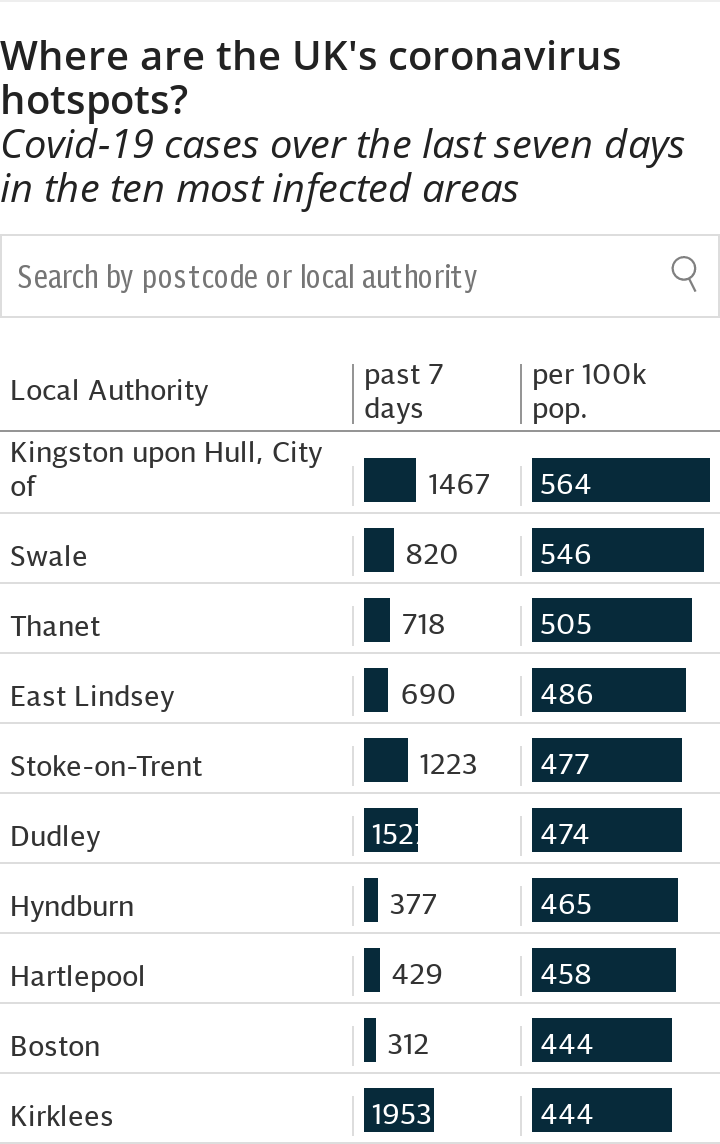UK on course for only fraction of Covid-19 cases projected by government scientists

If current rates of confirmed Covid-19 infections continue, the UK is on course for around 11,000 new cases a day by mid-October - a fraction of a projection made by the Government's chief scientists last week, Telegraph analysis has found.
Yet the latest data also shows over 10 million people live in areas where the number of new coronavirus cases confirmed each day has already risen faster than the rate used in the scientists' scenario.
Last week at Downing Street chief scientific adviser Sir Patrick Vallance presented a scenario in which the number of new confirmed cases could reach close to 50,000 a day across the UK by October 13 if it began doubling every seven days.
Sir Patrick made clear the scenario was “not a prediction” but an example of how the virus can spread when left unchecked.
It was based on the situation as of September 15, when 3,105 new cases were reported across the UK. Since the dire warning the UK has seen the highest daily rise in detected infections since the start of the pandemic, with 7,143 reported cases on Tuesday.
Had the number of new cases been doubling every seven days, the UK would have been reporting closer to 12,500 cases a day by this time.
Based on a seven-day rolling average, the rate of newly reported Covid-19 cases has been doubling every 15 days, from around 3,000 on September 15th to 6,000 on September 29.
If that rate continues, the UK will be seeing more than 11,000 new cases a day by October 13th.
At a coronavirus briefing at Downing Street on Wednesday evening, Sir Patrick defended the data that he presented.
"The illustration was to point out that epidemics either double or halve, they're either growing or shrinking," he said. "And doubling means things go very big very quickly. And when things double you see that exponential growth and there's clearly fast growth in some areas.
"And unfortunately as we've seen not only cases going up, but we're already seeing an increase in deaths. So things are heading in the wrong direction."
While the trajectory of confirmed cases is rising more slowly than the Government projection, it does not tell the whole story.
While testing capacity has increased infections are still being missed - and confirmed cases remain an underestimate of the true picture.
According to the Covid Symptom Study, the number of new daily Covid-19 cases is now close to 20,000 a day, amid warnings the rate of new cases is doubling every seven days in some of the UK's worst-affected areas.
Tim Spector, Professor of Genetic Epidemiology at King's College London who leads the research, said: “The number of cases in the UK continues to rise at an alarming rate as we are seeing figures doubling weekly across the country, in particular we are worried about places like London and other major cities like Manchester, Belfast and Glasgow where cases are surging and the R value is around 1.4.”
Cases doubling weekly in local pockets
Though the UK as a whole is not seeing cases double every seven days, 67 local authority areas representing 10.5m people have seen daily new case rates accelerate at at least this rate.
Newcastle upon Tyne, for instance, has seen 967 new cases of Covid-19 between September 16 and September 25, compared to 574 if infections in the area had been doubling every week from September 15.
The area is part of the North East lockdown, where the Government has introduced a ban on households mixing indoors, including in pubs and restaurants, that is legally enforceable with fines from Wednesday, September 30.
Likewise Swansea, which was put under local lockdown by the Welsh Government on Sunday, has seen 285 new cases of Covid-19 in the same period, more than double the 123 cases it would have seen if infections were doubling every week.
By the same token, around 56.3m people live in areas which have not seen cases rise at the same rate as the scientist's grim projection, suggesting new national measures such as the 10pm curfew for pubs and restaurants may have helped slowed the virus's spread.
Infections spreading to older people
While the rise is being driven by younger people picking up infections and getting tested, the rate of new cases is continuing to rise among older, more at-risk, people.
Infections among the 20 to 29 age group rose above 20 per 100,000 in the week to August 16, according to the latest data from Public Health England (PHE).
Infection rates followed among other age groups shortly afterwards, rising above 20 per 100,000 among 30 to 59 year olds by the week ending September 6th, and 60 to 69 year olds by the following week.
The spread of infections reached those aged 80 and above sooner, despite them being the most high risk group. Infection rates hit 20 per 100,000 in the week ending September 6th.
Enter your postcode or the name of a local authority below to see the latest infection rates in your area



